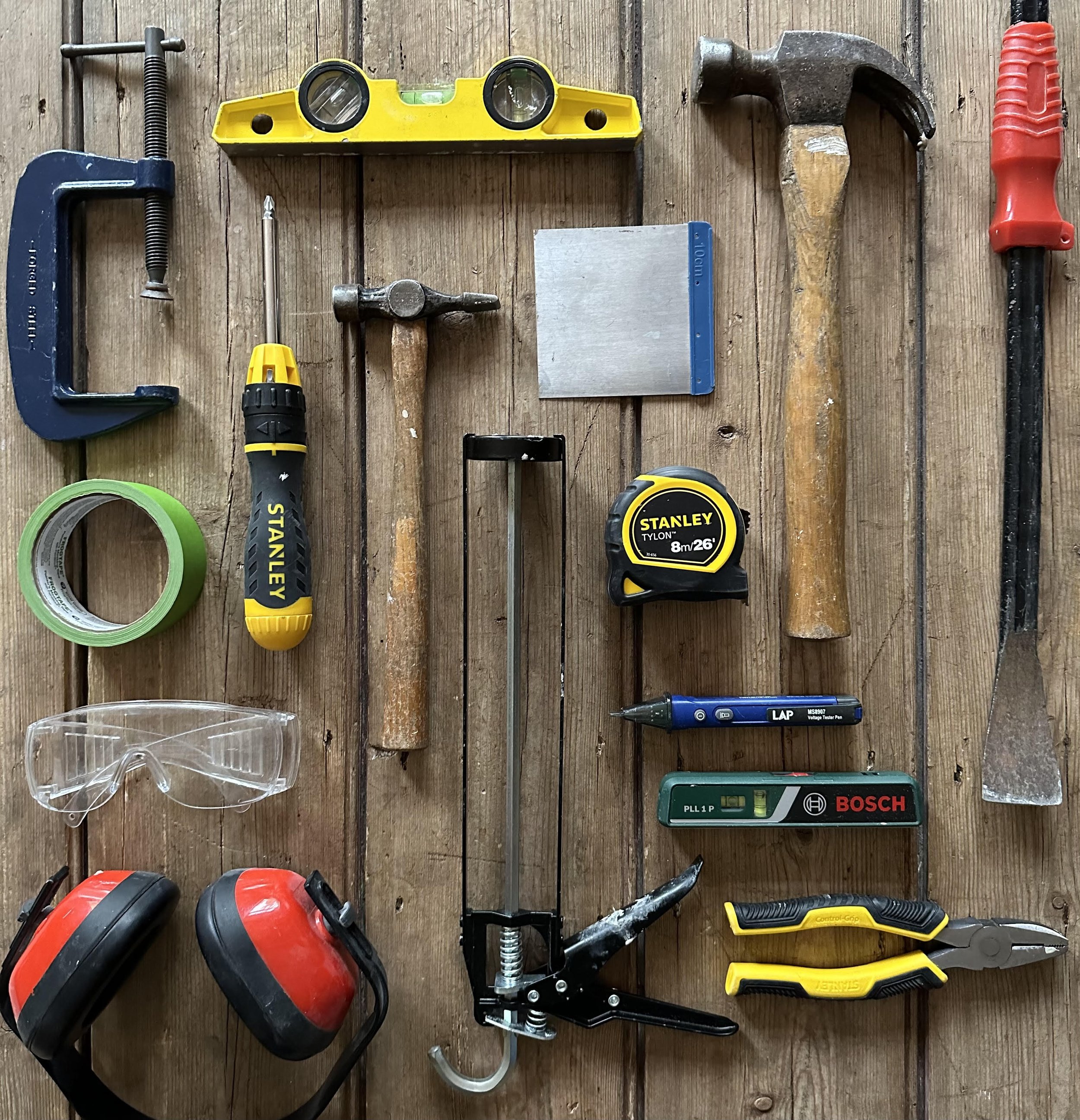The tools you need to get started with DIY
Post contains affiliate links.
There is so much information online nowadays about every DIY project under the sun - to the point where it can become overwhelming as you scroll from one YouTube tutorial to another. However, if you’re taking on a renovation project or have some tasks you’d like to tackle yourself and you’re wondering how to get started, here’s a list of the tools I use the most.
I am no expert and I wouldn’t even claim DIY comes naturally to me, but we’re three house renovations (in nine years) deep so I have had a fair amount of experience - from putting up shelves to panelling walls, changing light switches, flooring or putting up a curtain pole, there are so many tasks you can do yourself to save money.
It’s certainly not necessary to have all these tools at the beginning. You may want to spread the cost out and buy as and when you need something. This is what we have done, though I must confess this approach can be a bit stressful when you’re halfway through a project and realise you don’t have the tool you need.
If you’re looking specifically for tips on electric sanders, read my blog post here.
Basic Tool Kit for DIY Beginners - Essential Items
Spirit Level: Useful for hanging shelves, picture frames or mirrors not to mention a myriad of other tasks too. A spirit level will be far more accurate the spirit level app on your phone - sorry!
Ratchet screw driver with interchangeable pieces: A screwdriver will always be one of the most used tools in your toolbox, so go for a ratchet model (easier to turn and tighten) with interchangeable pieces so you can change the head from cross head to flat head and many other options too. This will save you money and space rather than buying multiple different screwdrivers.
Hammer and claw hammer: A claw hammer is useful for many tasks most noticeably pulling out rawl plugs - I find ours (it belonged to my Grandfather) quite heavy so prefer using the smaller hammer for more general hammer usage.
Pliers: Good quality pliers will come in handy on many projects and are a must have in your tool kit.
Tape measure: ‘Measure twice, cut once’ isn’t the most shared DIY tip for nothing! Ensure you have a good tape measure so you can build accurate projects.
Caulking/sealant gun: Another cheap item that doesn’t have a workaround. If you’re buying caulk, sealant, most adhesives - you will not be able to use the tube they come in without a caulking gun. Therefore this is another essential purchase for your toolkit - and thankfully it’s super cheap too. Just make sure you get the bigger size so it fits all caulking/sealant tubes.
Laser spirit level: Useful if you’re wallpapering, putting up a gallery wall, shelves or panelling. Easy to use, a simple laser level is a super useful tool to have in your back pocket.
Stanley knife (not pictured): Doesn’t have to be a Stanley but a retractable knife with changeable blades is a definite must have in your tool box - super useful for all sorts of tasks.
Basic Tool Kit for DIY Beginners - Secondary Items
Clamp: Useful for keeping wood in place whilst you’re cutting it. I would recommend owning three if you’re planning on cutting panels of wood, one would be enough if you’re cutting smaller pieces.
Filling knife: These are cheap as chips and come in sets of three or four with different sizes. Useful for applying filler on walls and other similar tasks.
Wrecking bar: Slightly different to the one pictured, but a wrecking bar will make light work of any demolition work you have.
Voltage tester: A voltage tester can check for live wires which is useful if you’re drilling holes in walls near sockets or switches, or a little more advanced, changing the switch plates for your switches and sockets.
Ear defenders: If you’re feeling brave and using power tools, you will need to get a pair of ear defenders to protect your ears. Sanding and mitre saws in particular are common tools that can create quite a racket!
Safety goggles: Another item necessary if you’re planning any demolition or power tool usage - protect your eyes - you need them for further projects!
Decorators tape: I use Frog Tapes and haven’t found a cheaper alternative I prefer yet. These are useful for decorating, colour blocking, painting stripes and protecting your glass when painting windows.
Power tools for Diy Beginners:
The term power tools make these seem more daunting than they are but I promise you these are all very easy to use. The drill is an absolute must have and will probably become your most used tool in your tool kit. It’s worth investing in a good one as you really will get frustrated trying to use one that isn’t powerful - it just makes an already stressful situation (doing DIY!) even more stressful!
The Dewalt Orbital Sander is another tool I use all the time. If budget were no option I’d buy the cordless version as I sometimes find the wire can get a bit heavy when sanding for a very long time (especially walls and ceilings). If you want to know more about my sander recommendations, you can read my blog post here.
The mitre saw from Erbauer is a bit more of an advanced tool. It’s straightforward to use however you will only need one if you’re doing a lot of woodwork. It is invaluable for tasks like skirting board, carpentry, building shelves or furniture and panelling. We use it a lot for cutting up scraps for kindling but that is a bit more of a niche task!
The multitool has many uses as you can change the attachment at the top. I use the blades the most as they are helpful for odd bits and bobs like cutting a small bit out of skirting board, or cutting screws to size for cabinet furniture, I also use the sanding attachment for fiddly bits on sanding projects and overall it’s just a very handy problem solver.
FAQ:
I’m on a budget, where can I find tools?
A lot of the basic essentials can be bought quite cheaply, but I also recommend keeping an eye out at car boots, garage sales or house clearances. If you have elderly grandparents who are no longer doing their own diy, it may be worth seeing if they would be happy to pass some on - good tools last forever!
When it comes to power tools though, I find buying super cheap is a false economy - I know they say a workman should never blame his tools, but every now and then this is actually the case, and I’ve had so many projects that have taken 10x longer than they should have because of using tools that just aren’t up to the task.
How can I learn more about DIY?
It’s worth looking around locally for courses or workshops in DIY as there are certainly more popping up. If you’re in Mid-Sussex, How to Basically do in-person workshops and online courses too. The Good Life Centre offers DIY for beginners in London and The Boho Shed offers workshops for women up north, covering Lancashire, Cheshire and Greater Manchester.
Who can I follow for DIY tips?
@gentdecorating - Sanding, prepping, painting and decorating tips
@grillodesigns - Achievable DIY projects on a relatable budget
@thelovelydrawer - Renter friendly DIY hacks
@sympathetic_restoration - Great tips for renovating period houses





